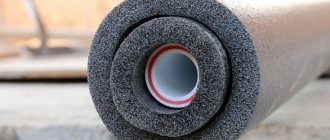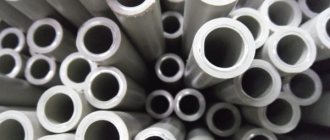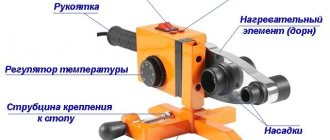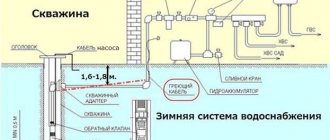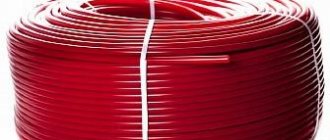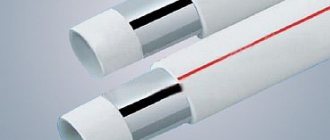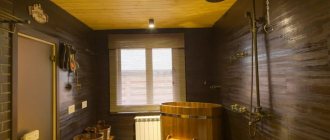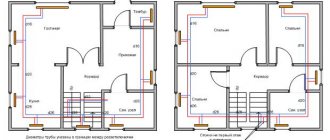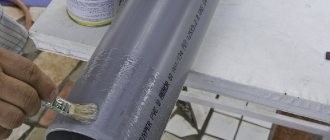Installation of HDPE pipes requires specialized equipment, certain knowledge and skills. High-quality installation of the pipeline eliminates the occurrence of leaks and guarantees trouble-free operation of the network and associated components.
In this article we will tell you how to install HDPE pipes for water supply. The information will be useful to production workers and novice craftsmen; it will help organize polyethylene water supply with low temporary losses.
Features of HDPE pipes
Water supply lines based on HDPE pipes have become widespread. They are in demand in agriculture and are used on private and commercial properties.
The high popularity of HDPE pipelines is due to the following factors.
- Chemical resistance. Systems based on HDPE work with drinking water, as well as low-aggressive media. They do not affect the composition of the transported product and do not create favorable conditions for the development of pathogenic microflora.
- Smooth inner surface. The HDPE pipeline does not contain grooves, bumps or other defects. This prevents the formation of deposits and allows you to maintain the permeability of the system for a long time.
- Resistance to corrosion. Rust does not appear on the surface of polyethylene pipelines. Maintaining the main line does not involve painting or removing corrosion.
- Low installation costs. Pipes based on HDPE are laid in the ground. When arranging the water supply system, concrete trays and other auxiliary components are not used.
- Dielectric properties. Polymer pipes do not conduct current and do not require additional insulation. They can be used as a cable route when connecting power equipment.
- Long service life. A polyethylene pipeline remains functional for 50 years. Compliance with operating rules increases the indicator to 60 and even 75 years.
- Light weight. The low weight of HDPE pipes allows you to save on delivery, loading, unloading and installation. The products slightly load the supporting elements when installed indoors.
- Excellent elasticity. Installation of HDPE pipes is simplified by their plasticity. The components bend without loss of strength and maneuverability. This minimizes the number of bends and adapters and allows the use of pipes in areas with increased vibration and seismic activity.
Significant elasticity guarantees resistance to water hammer and eliminates the risk of pipes bursting when water freezes in them.
The main disadvantage of the material is its vulnerability to high temperatures. When heated above 80 degrees, a decrease in the strength of products is observed.
There are two types of HDPE pipes on sale - intended for highways:
- working under pressure - gas and water supply networks;
- transporting the product by gravity - storm drains and sewerage systems.
Products differ in wall thickness and installation specifics.
Preparatory work and installation stages
Pipes are not buried deep into the ground, since the water is drained for the winter.
The layout of the water supply network on a personal plot will depend on which pipeline will be installed - permanent or collapsible.
The last option is much easier to make with your own hands. It consists of hoses, which are made of silicone or plastic, and connecting parts made of plastic, plastic or steel. Using special high-quality connections, you can create a joint that will not leak.
Most often, water supply is made from polypropylene pipes, which are sloped relative to the source of water supply. The slope to the drain valve should be approximately 8-15 degrees. If the water supply system is stationary, it is best to place it in shallow trenches and bring several irrigation taps to the surface.
Before you begin installation, you need to prepare a drawing to make it easier to calculate how much material will be required. At this design stage, it is necessary to calculate the number and size of pipes, other tools and materials.
After marking, you can start digging the trench. Its optimal depth is 0.4 meters, except when pipes are laid under the beds.
Watering can be done using an irrigation system or a hose. A valve or inlet valve is installed at the junction of the pipeline and the central main. Pipes made of low-density polyethylene are connected to the inlet valve with a coupling. It is located on the outer and inner sides - it depends on the location of the thread. After securing the connection, install a piece of pipe with a hose and a tee.
Pipe bending
When installing a summer water supply system at your dacha, it is important to know in what ways you can bend the pipes so as not to damage their integrity
- To make the bend, you will need several plugs that are filled with sand. This method reduces the likelihood of fractures to a minimum. As an alternative, you can use wooden choppers rather than plugs. Pipes are made of different strengths, so it is difficult to say how much effort will have to be applied. The simplest method of bending is to insert another one into the pipe, but with a small cross-section, find a stop and give it the desired shape, exerting physical pressure.
- Square-shaped and large-diameter pipes are bent using a torch and sand.
- For aluminum and steel pipes you will also need a torch. The product is covered with sand and plugs are placed on both sides. The required area is heated red-hot and bent.
If used incorrectly, the torch can leave a hole in the building material, so it is recommended to move it aside regularly.
How to manually bend pipes
To independently bend pipes made of metal-plastic, you must strictly follow the following recommendations:
- Fold slowly and without sudden movements.
- To obtain the required angle of inclination, it is necessary to lay pieces of wire before the bend.
- The larger the lever of the pipe put on the structure, the easier it is to bend it.
To bend polypropylene pipes, heat the required area with a hairdryer to 150 degrees. The segment with the thickest wall is bent. They also bend the building material without preheating, but then the maximum angle of inclination will be 8 degrees. Before filling the system with water, check the pipes for defects and damage.
Connecting pipes using welding
Laying pipes by welding is based on the ability of heated polymers to mix with each other (diffusion). The procedure allows you to obtain one-piece units of increased strength. Such connections are in demand at industrial enterprises and critical economic facilities.
Installation of pipes using the diffusion method requires the presence of the following equipment:
- profile welding machine;
- centering clamps;
- trimmers.
The pipeline is laid in several stages:
- the pipes are cut perpendicular to the guide;
- rigidly fixed with clamps;
- the joining surfaces are cleaned with a trimmer;
- the cuts are heated with a welding machine to a given temperature;
- the ends of the pipes are connected with the required force;
- the joint is allowed to cool.
Upon completion of installation activities, the quality of the assembly is checked.
Electrofusion welding
The welding procedure, which involves the use of special fittings and installations, places high demands on the preparation of the ends and simplifies work in hard-to-reach places.
To install pipelines using electric couplings, you will need to perform a number of operations:
- cut pipes taking into account the depth of the fittings;
- carry out mechanical and chemical treatment of cuts, removing irregularities and contamination;
- insert the prepared edges into the sleeve;
- connect the contact wires of the welding machine to special connectors on the fitting;
- activate the welding process.
The duration of the current supply is determined by the coupling parameters. The barcode on the product helps to set the indicator correctly.
HDPE pipes for a water supply system at the dacha: do-it-yourself installation
Polyethylene multilayer pipes (HDPE) are a complex structure created by the polymerization of ethylene without the use of high pressure. Thanks to their multilayer structure, these pipes are quite strong and at the same time flexible. Low cost, variety of types and unpretentiousness make it possible to use HDPE pipes for water supply in the country, the installation of which is easy to do with your own hands.
Related article: Watering the site
At your summer cottage, you can install a water supply using polyethylene pipes
Connection using fittings
A simple and affordable way to install pipes. When carrying out work, compression fittings with specified characteristics are used. Manufacturers offer a variety of mounting components. The wizard can assemble standard components, as well as implement non-standard solutions for connecting additional equipment.
The connection of pipes using fittings occurs as follows:
- cutting a pipe of a given size, cleaning its end;
- disassembling the fitting, removing the blue nut;
- putting the connector parts on the pipe, starting with the nut;
- pushing the end of the pipe into the center of the fitting;
- fixing the nut after contact between the pipe and the stop.
To secure the response element, the operation is repeated in the same sequence.
Upon completion of work, it is necessary to check the quality of connections. The presence of distortions, large gaps and other defects that contribute to depressurization of the circuit is unacceptable.
Types of detachable fittings for HDPE pipelines
A wide range of elements are used during installation operations:
- couplings connecting flat sections of the highway;
- bends creating corner connections;
- tees and crosses that form additional branches.
Manufacturers offer various adapters. Some allow you to connect plastic and metal components, others make it easier to work with polyethylene pipes of different diameters.
Methods for connecting low-density polyethylene pipes
There are several ways to connect HDPE pipes during installation. The choice depends on the final purpose of the pipeline.
Docking methods:
- Diffuse butt welding requires a special welding machine. Used for installation of industrial pipelines. When laying private communications, there is no need for such a degree of reliability in connection.
- Electrofusion welding.
- Connection using special fittings.
The first two connection methods are permanent. Connections that have been assembled using compression fittings can be dismantled.
Welding connection
Welding joints of polyethylene pipes are made end-to-end using the diffuse welding method. The joining principle is based on the ability of polymers to mix when heated. Diffusion (mutual penetration) of part materials occurs at the molecular level. The result is a monolithic connection, which is not inferior in strength to the pipe body.
Note! Butt welding is possible if the wall is thick enough. This technology is used for pipe diameters from 50 mm with a wall thickness of 5 mm.
To work you will need:
- special welding machine;
- clamps for pipe alignment;
- trimmer
Work algorithm:
- The material is cut strictly perpendicular to the guide. The cuts must be smooth and clean.
- The material is fixed rigidly with clamps (positioner).
- Clean the cuts using a trimmer.
- The sections are simultaneously heated using a welding machine. The heating time depends on the thickness of the pipe wall and is indicated in special tables.
- Connect the heated edges end to end, pressing them with physical force. Allow the connection to cool.
Note! Pipe material from different manufacturers may not produce a high-quality weld, since the material may vary slightly in composition.
Electrofusion welding
Welding using electrical fittings is a simpler process. It does not require special skills, but you can’t do it without a welding machine. Requirements for section preparation remain high.
We recommend that you read: How to independently build a chimney in a bathhouse with an exit through the wall?
Electrofusion welding is used for pipeline installation in hard-to-reach places.
The essence of the process is that the fitting has built-in heating elements and contacts that are brought out. When connecting an electrical fitting to a welding machine, the parts melt and are connected. This method can also be called diffuse welding, since the differences here are only in technology.
Note! Electrofusion welding allows you to obtain a seamless connection on pipes with different diameters. However, it should not diverge by more than 10%.
The process looks like this:
- The pipes are cut to size, taking into account the coupling.
- The cuts must be at an angle of 90 degrees. They should be cleaned of burrs and degreased.
- The prepared edges are inserted into the sleeve.
- Connect the built-in electrodes to the electric welding machine.
- The welding time is determined by the fitting barcode.
Connection using fittings
For independent installation of water supply or sewerage in the house, connections using compression fittings will be sufficiently reliable. Manufacturers offer a lot of variations that allow you to assemble any pipeline configuration.
Schematically, the process of connecting HDPE materials using fittings can be described as follows:
- We prepare the pipe by making a strictly perpendicular cut. It should be cleaned of burrs and dirt.
- Unscrew the fitting by removing the blue nut.
- Sequentially, starting with the nut, we put all the parts on the pipe.
- We insert the end of the pipe into the fitting, pushing it to the middle.
- Use a nut to secure the connection. For reliability, tighten with a wrench.
- We repeat the operation with the second pipe.
Note! If you remove only the nut from the fitting and try to push the pipe inside with the internal parts assembled, the joint will become leaky. The mistake is that the pipe will not go deep enough to be properly fixed.
Types of detachable fittings for HDPE pipelines
Manufacturers offer a full range of possible connections.
Detachable fittings are:
- for connecting straight sections - couplings;
- for wiring - tees;
- for contours - corners:
- shut-off valves – valves;
- for transition to metal pipes - compression fittings with threads (internal, external);
- to change to another diameter.
We recommend that you read: Drainage pipe wrapped in geotextile: features and installation rules
Fasteners
The efficient operation of the pipeline is ensured by fastenings. They prevent displacement of the line, weakening of detachable units and deformation of loaded elements.
Fixing components during system installation occurs in two ways:
- formation of a fixed connection using special clamps;
- formation of a movable connection using hooks.
When laying a pipeline, it is necessary to fix each joint. The components holding the linear sections are placed in increments equal to ten times the pipe diameter. The use of clamps involves the installation of rubber gaskets that prevent mechanical damage to the line.
Pipe laying methods
There are two ways in which you can arrange a water supply and provide yourself with communications:
- Ground (open). This method is very popular among summer residents, because the system can not only be quickly assembled, but also quickly disassembled and stored, thereby ensuring the safety of materials during the cold season. It is mounted on (above) the surface of the earth in the form of a contour with tightening fittings at joints or branches. But, given that if handled carelessly, open water supply lines can be damaged by gardening or agricultural machinery, it is preferable to install lines on special stands (supports). When installing such a system, take into account all the nuances of its operation.
- Underground (trench). The pipeline can also be laid underground by placing collectors in trenches. In this case, it would not hurt to install additional fencing or hang tape along the water supply lines. If a stationary underground water supply system is planned, it is better to supplement the trenches with a heating cable so that the main operates at any time of the year.
HDPE pipes for water supply systems in summer cottages are chosen because their assembly is accessible to anyone without the use of expensive equipment. The main thing is that the communication scheme is carefully thought out in advance, and the details for its implementation are interconnected.
Related article: Do-it-yourself summer water supply at the dacha
Possible installation errors
Carrying out installation activities on water pipelines can be overshadowed by certain oversights:
- joining pipes with untreated ends;
- distortions of pipes within the coupling or weld;
- defects that reduce the tightness of the unit;
- use of substandard connecting elements;
- use of rigid fasteners without taking into account the linear expansion of materials;
- violation of welding regulations (excessive heating, non-compliance with temperature exposure periods).
Defective connections must be removed. Their place is taken by new sealed joints, made in accordance with the regulations.
Scope of use of HDPE pipes
Polymer pipelines are used when laying highways transporting the following media:
- drinking and technical liquids;
- gas fuel;
- wastewater;
- sewage;
- liquid technological products of low aggressiveness.
It will help to purchase pipes and components for connecting them. The company offers certified products of domestic and foreign production, rents out welding machines and other equipment.
To submit an application, contact the organization's managers. Specialists will talk about the parameters of cooperation and recommend solutions that meet your needs.
